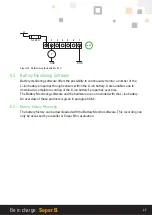
28
7. Inspection and cleaning
7.1. General information
!
Warning!
Never attempt to open or dismantle the Li-ion battery! The inside of the Li-ion
battery does not contain serviceable parts.
1. Disconnect the Li-ion battery from all loads and charging devices before performing cleaning and
maintenance activities (see paragraph 4.7).
2. Remove the fuse or dummy fuse before cleaning and maintenance activities (see paragraph 4.3.2).
3. Place the enclosed protective caps over the terminals before cleaning and maintenance activities to
avoid the risk of contacting the terminals.
7.2. Inspection
1. Inspect for loose and/or damaged wiring and contacts, cracks, deformations, leakage or damage of any
other kind. If damage to the Li-ion battery is found, it must be replaced. Do not attempt to charge or
use a damaged Li-ion battery. Do not touch the liquid from a ruptured Li-ion battery.
2. Observe and note the run time that a new, fully-charged Li-ion battery provides for powering your
product. Use this new Li-ion battery run time as a basis to compare run times for older batteries. The
run time of the Li-ion battery will vary depending on the products’ configuration and the application it is
used for.
3. Routinely check the Li-ion battery’s SOC. Lithium Iron Phosphate batteries continue to slowly self-
discharge (<3% per month) when not in use or stored.
4. Consider replacing the Li-ion battery with a new one if you note either of the following conditions:
- The Li-ion battery run time drops below about 80% of the original run time.
- The Li-ion battery charge time increases significantly.
7.3. Cleaning
If necessary, clean the Li-ion battery with a soft, dry cloth. Never use liquids, solvents, or
abrasives to clean the Li-ion battery.
Содержание NOMIA 12V210AH
Страница 1: ...Manual NOMIA 12V210Ah Version February 2021 ...
Страница 33: ...33 Be in charge Super B ...







































